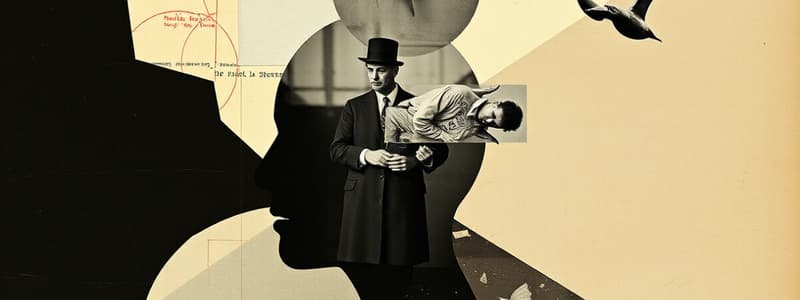Podcast
Questions and Answers
What is the primary distinction between bottom-up and top-down processing?
What is the primary distinction between bottom-up and top-down processing?
- Top-down processing occurs first in the perception cycle, while bottom-up processing completes it.
- Bottom-up processing uses sensory information to build perception, while top-down processing uses existing knowledge. (correct)
- Bottom-up processing relies on prior knowledge, while top-down processing is data-driven.
- Bottom-up processing incorporates direct thought processes, while top-down processing does not.
Which theory supports the idea that perception is based solely on sensory information without the need for cognitive processes?
Which theory supports the idea that perception is based solely on sensory information without the need for cognitive processes?
- Direct perception theory (correct)
- Feature-matching theories
- Template theories
- Recognition-by-components theory
In bottom-up processing, what type of cues do we often rely on to perceive depth and distance?
In bottom-up processing, what type of cues do we often rely on to perceive depth and distance?
- Previous experiences with objects
- Texture gradients (correct)
- Color contrasts
- Knowledge of object function
Which theory is associated with the specific recognition of objects based on their features and component parts?
Which theory is associated with the specific recognition of objects based on their features and component parts?
Which approach emphasizes that perception is informed by both stimuli and cognitive processes?
Which approach emphasizes that perception is informed by both stimuli and cognitive processes?
What is a key characteristic of bottom-up processing in perceptual theory?
What is a key characteristic of bottom-up processing in perceptual theory?
Which of the following theories posits that we have templates stored in memory to match incoming sensory input?
Which of the following theories posits that we have templates stored in memory to match incoming sensory input?
How does ecological perception relate to bottom-up processing in perception?
How does ecological perception relate to bottom-up processing in perception?
What does bottom-up processing primarily rely on?
What does bottom-up processing primarily rely on?
Which method involves integrating sensory information with pre-existing knowledge?
Which method involves integrating sensory information with pre-existing knowledge?
What characterizes bottom-up processing?
What characterizes bottom-up processing?
Which approach is more likely to result in ambiguity during perception?
Which approach is more likely to result in ambiguity during perception?
In perceptual processing, where do the primary sensory inputs start in bottom-up processing?
In perceptual processing, where do the primary sensory inputs start in bottom-up processing?
What is the main function of top-down processing in perception?
What is the main function of top-down processing in perception?
Which statement accurately describes the process of constructing perception in bottom-up processing?
Which statement accurately describes the process of constructing perception in bottom-up processing?
Which best describes the term 'constructive perception' in the context of top-down processing?
Which best describes the term 'constructive perception' in the context of top-down processing?
How does top-down processing fundamentally differ from bottom-up processing in terms of perceptual input?
How does top-down processing fundamentally differ from bottom-up processing in terms of perceptual input?
In which scenario would bottom-up processing be more effective than top-down processing?
In which scenario would bottom-up processing be more effective than top-down processing?
What primarily distinguishes top-down processing from bottom-up processing in human perception?
What primarily distinguishes top-down processing from bottom-up processing in human perception?
Which element is a key component of bottom-up processing?
Which element is a key component of bottom-up processing?
What role do semantic regularities play in the perception process?
What role do semantic regularities play in the perception process?
In the context of perception, how do context effects facilitate top-down processing?
In the context of perception, how do context effects facilitate top-down processing?
What is implied by the statement that individuals may 'see' things that aren't there when engaging in top-down processing?
What is implied by the statement that individuals may 'see' things that aren't there when engaging in top-down processing?
What is the primary characteristic of bottom-up processing in perception?
What is the primary characteristic of bottom-up processing in perception?
Which theory emphasizes the role of experiences and expectations in processing perception?
Which theory emphasizes the role of experiences and expectations in processing perception?
What was one major departure of Gestalt psychologists from structuralism?
What was one major departure of Gestalt psychologists from structuralism?
What does the term 'Gestalt' specifically refer to in psychology?
What does the term 'Gestalt' specifically refer to in psychology?
Which of the following best describes the 'Theory of Unconscious Inference'?
Which of the following best describes the 'Theory of Unconscious Inference'?
How do Gestalt principles explain the organization of visual scenes?
How do Gestalt principles explain the organization of visual scenes?
What key aspect differentiates top-down processing from bottom-up processing?
What key aspect differentiates top-down processing from bottom-up processing?
Which type of processing would be best suited for recognizing a familiar face in a crowd?
Which type of processing would be best suited for recognizing a familiar face in a crowd?
What principle does NOT belong to the Gestalt Principles of Organization?
What principle does NOT belong to the Gestalt Principles of Organization?
Which concept is most closely associated with the criticism of structuralism in perceptions?
Which concept is most closely associated with the criticism of structuralism in perceptions?
What primarily drives top-down processing in perception?
What primarily drives top-down processing in perception?
Which of the following best describes bottom-up processing?
Which of the following best describes bottom-up processing?
Which aspect of recognition-by-components (RBC) theory poses a problem?
Which aspect of recognition-by-components (RBC) theory poses a problem?
What is one effect of top-down processing as demonstrated by Palmer (1975)?
What is one effect of top-down processing as demonstrated by Palmer (1975)?
What characterizes the cognitive approach of top-down processing?
What characterizes the cognitive approach of top-down processing?
What is a limitation of the recognition-by-components (RBC) theory?
What is a limitation of the recognition-by-components (RBC) theory?
Which process primarily uses sensory information to build up a perception?
Which process primarily uses sensory information to build up a perception?
Which statement best reflects the role of context in object identification, as per Palmer's experiment?
Which statement best reflects the role of context in object identification, as per Palmer's experiment?
What process do people rely on when faced with ambiguous stimuli, according to the top-down approach?
What process do people rely on when faced with ambiguous stimuli, according to the top-down approach?
Study Notes
Fundamental Processing of Human Perception
- Two main types of processing: Bottom-up and Top-down
- Bottom-up processing involves identifying parts, combining them, and then achieving recognition.
- Top-down processing starts from the brain, utilizing prior knowledge and expectations to interpret sensory information.
Bottom-Up Processing
- Begins at sensory receptors and moves to the brain.
- Recognition is direct and not influenced by complex thought processes.
- Theories include:
- Direct perception theory (Gibson, 1966)
- Template theories
- Feature-matching theories
- Recognition-by-components theory (Biederman, 1987)
Gibson’s Theory of Direct Perception
- Proposes that sensory receptors provide all necessary information for perception.
- Emphasizes ecological perception through texture gradients, indicating depth and distance without needing complex reasoning.
Transduction
- The process of converting sensory stimuli into signals for the brain.
- Requires both qualitative (basic qualities) and quantitative (degree/magnitude) information about stimuli.
Perception Explained
- Perception is an experience from sensory stimulation and is shaped by environmental information.
- Relies on context and learned experiences to construct meaningful interpretations.
Gestalt Principles of Organization
- Developed by Gestalt psychologists in the 19th century, counteracting structuralism's view of perception.
- Gestalt means “organized whole,” emphasizing the brain's intrinsic laws for grouping perceived features into wholes.
- Principles illustrate how perception is not simply the sum of its parts.
Recognition-by-Components (RBC) Theory
- Focused on Geons: simple, viewpoint-invariant geometrical shapes.
- Addresses how objects can be identified from their components regardless of viewpoint.
- Does not fully explain recognition of specific objects sharing the same geons.
Top-Down Processing
- Operates by constructing perceptions from prior knowledge and cognitive processes.
- Allows for quicker identification of objects within expectations, potentially leading to misinterpretations.
- Influenced by context effects, where environmental cues shape perception.
Context and Semantic Regularities
- Contextual surroundings significantly affect how stimuli are perceived.
- Semantic regularities are characteristics related to the functions of various scenes, influencing object perception based on prior knowledge.
- Scene schema contributes to expectations, aiding in the identification of objects in typical environments.
Overall Structure of Content
- The text covers Sensation and Perception, detailed theories of object perception, and the neural pathways involved in perception.
- Also addresses deficits of perception in dynamic contexts.
Studying That Suits You
Use AI to generate personalized quizzes and flashcards to suit your learning preferences.
Related Documents
Description
This quiz explores the concept of top-down processing in human perception, focusing on the fundamental principles of perception and its contrast with bottom-up processing theories. It delves into how our brains interpret sensory information and the role of cognitive processes in perception.



